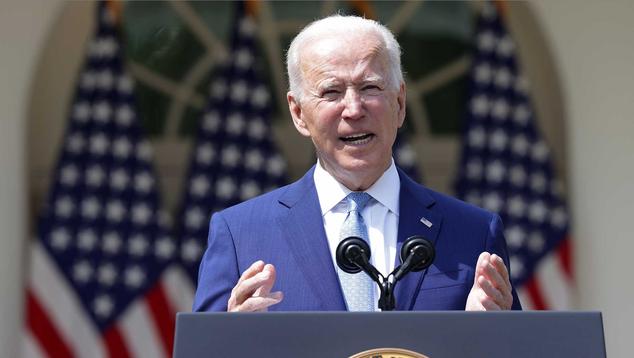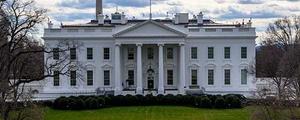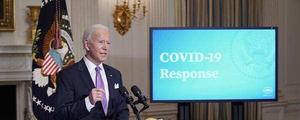Story Highlights
- Biden's party gap nine points larger than Trump's; 30 points above others'
- Double digits separate approval among college graduates and nongraduates
- Biden's race, gender gaps on approval essentially the same as Trump's
WASHINGTON, D.C. -- President Joe Biden's job approval ratings during his first two full months in office show greater divisions by party and educational attainment than those of his recent predecessors. Gaps in Biden's job approval by gender and race are similar to those of Donald Trump but larger than those of Barack Obama, George W. Bush and Bill Clinton.

Horizontal bar graphs. Gaps in approval for U.S. presidents among key subgroups. There is an 86-percentage point gap between Democrats and Republicans in approval for President Joe Biden. Additionally, there is a 13-point gap between college graduates and college nongraduates in approval of Biden. Among men and women, there is a 13-point gap in approval for Biden. There is a 33-point gap between White Americans and Non-White Americans in approval for Biden. By age, there is a 15-point gap between Americans aged 18-29 and those that are 65 or older.
The reasons behind the greater demographic cleavages in approval are complex and at times idiosyncratic. To some degree, the Biden pattern merely reflects shifts in certain groups' partisanship in recent decades, particularly for age and gender subgroups. But increasingly strong relationships between partisanship and job approval among partisans within subgroups, including by education and race, are also a factor. In some cases -- for example, gender and education -- emerging differences in the way independents evaluate presidents contribute to the wider gaps.
These findings are based on combined data in Gallup polls conducted from each president's January inauguration through the end of March in the same year. This period covers roughly the first 2 1/2 months of each president's term.
Biden has averaged 56% job approval over this period, similar to the averages for Clinton (55%) and Bush (58%). Obama had a higher job approval average during the same period of his presidency (64%), while Trump's was significantly lower, at 42%.
Biden Party Gaps Nearly 10 Points Higher Than Trump's; 30 Points Above Others'
An average of 86 percentage points have separated Democrats' (96%) and Republicans' (10%) ratings of Biden so far, eclipsing the 77-point gap in the early ratings of Trump. This difference results from Biden's higher scores among his fellow partisans than Trump received (87% among Republicans). Each got the same low 10% approval ratings from supporters of the opposition party.
Party gaps in approval ratings were about 30 points lower for Obama, Bush and Clinton than they have been for Biden. This is primarily because about one-third of opposition-party supporters approved of the job those presidents were doing early in their terms.
But Biden's approval rating among his fellow Democrats is also higher than those for Obama (89%) and Clinton (78%) among Democrats, and for Bush among his fellow Republicans (89%).
| Democrats | Independents | Republicans | Difference (Democrats vs. Republicans) |
||||||||||||||||||||||||||||||||||||||||||||||||||||||||||||||||||||||||||||||||||||||||||||||||
|---|---|---|---|---|---|---|---|---|---|---|---|---|---|---|---|---|---|---|---|---|---|---|---|---|---|---|---|---|---|---|---|---|---|---|---|---|---|---|---|---|---|---|---|---|---|---|---|---|---|---|---|---|---|---|---|---|---|---|---|---|---|---|---|---|---|---|---|---|---|---|---|---|---|---|---|---|---|---|---|---|---|---|---|---|---|---|---|---|---|---|---|---|---|---|---|---|---|---|---|
| % | % | % | pct. pts. | ||||||||||||||||||||||||||||||||||||||||||||||||||||||||||||||||||||||||||||||||||||||||||||||||
| Biden | 96 | 55 | 10 | 86 | |||||||||||||||||||||||||||||||||||||||||||||||||||||||||||||||||||||||||||||||||||||||||||||||
| Trump | 10 | 38 | 87 | 77 | |||||||||||||||||||||||||||||||||||||||||||||||||||||||||||||||||||||||||||||||||||||||||||||||
| Obama | 89 | 61 | 33 | 56 | |||||||||||||||||||||||||||||||||||||||||||||||||||||||||||||||||||||||||||||||||||||||||||||||
| Bush | 32 | 55 | 89 | 57 | |||||||||||||||||||||||||||||||||||||||||||||||||||||||||||||||||||||||||||||||||||||||||||||||
| Clinton | 78 | 51 | 28 | 50 | |||||||||||||||||||||||||||||||||||||||||||||||||||||||||||||||||||||||||||||||||||||||||||||||
| Figures are based on average approval ratings in polls conducted from Jan. 20-March 31 in the year of the president's inauguration. | |||||||||||||||||||||||||||||||||||||||||||||||||||||||||||||||||||||||||||||||||||||||||||||||||||
| Gallup | |||||||||||||||||||||||||||||||||||||||||||||||||||||||||||||||||||||||||||||||||||||||||||||||||||
Independents' 55% approval of Biden during his inaugural period is similar to their ratings of Clinton and Bush, slightly lower than for Obama (61%), but well above the group's rating of Trump (38%).
Gap Between College Graduates and Nongraduates Now Double Digits
Before the Trump administration, evaluations of presidents differed little by education, with no more than a five-point difference in approval between Americans with a four-year college degree and those with less education than that. In the early months of Trump's presidency, the difference stretched to nine points. Under Biden, the gap between the two education groups has expanded to double digits, 13 points.
| College graduates | College nongraduates | Difference | |||||||||||||||||||||||||||||||||||||||||||||||||||||||||||||||||||||||||||||||||||||||||||||||||
|---|---|---|---|---|---|---|---|---|---|---|---|---|---|---|---|---|---|---|---|---|---|---|---|---|---|---|---|---|---|---|---|---|---|---|---|---|---|---|---|---|---|---|---|---|---|---|---|---|---|---|---|---|---|---|---|---|---|---|---|---|---|---|---|---|---|---|---|---|---|---|---|---|---|---|---|---|---|---|---|---|---|---|---|---|---|---|---|---|---|---|---|---|---|---|---|---|---|---|---|
| % | % | pct. pts. | |||||||||||||||||||||||||||||||||||||||||||||||||||||||||||||||||||||||||||||||||||||||||||||||||
| Biden | 64 | 51 | 13 | ||||||||||||||||||||||||||||||||||||||||||||||||||||||||||||||||||||||||||||||||||||||||||||||||
| Trump | 36 | 45 | 9 | ||||||||||||||||||||||||||||||||||||||||||||||||||||||||||||||||||||||||||||||||||||||||||||||||
| Obama | 65 | 64 | 1 | ||||||||||||||||||||||||||||||||||||||||||||||||||||||||||||||||||||||||||||||||||||||||||||||||
| Bush | 62 | 57 | 5 | ||||||||||||||||||||||||||||||||||||||||||||||||||||||||||||||||||||||||||||||||||||||||||||||||
| Clinton | 56 | 54 | 2 | ||||||||||||||||||||||||||||||||||||||||||||||||||||||||||||||||||||||||||||||||||||||||||||||||
| Figures are based on average approval ratings in polls conducted from Jan. 20-March 31 in the year of the president's inauguration. | |||||||||||||||||||||||||||||||||||||||||||||||||||||||||||||||||||||||||||||||||||||||||||||||||||
| Gallup | |||||||||||||||||||||||||||||||||||||||||||||||||||||||||||||||||||||||||||||||||||||||||||||||||||
Party preferences among education groups have changed greatly since Clinton was inaugurated. In 1993, college graduates were evenly divided in their party preferences (47% were Democrats or Democratic leaners and 45% were Republicans or Republican leaners), while nongraduates were a decidedly Democratic group (52% Democrats or Democratic leaners and 36% Republicans or Republican leaners). When Bush and Obama took office, there was little difference in party preferences between education groups.
By the time of Trump's inauguration, college nongraduates had become closely divided politically, while college graduates had become the heavily Democratic group. Currently, 45% of those without college degrees are Democrats or Democratic leaners and 46% are Republicans or Republican leaners. Among college graduates, the Democratic advantage is 58% to 34%.
Although the education groups have essentially switched places when it comes to partisanship, the groups are further apart in partisanship now -- 25 percentage points separate the net party preferences of college graduates (+24 Democrat/Democratic lean) and nongraduates (+1 Republican/Republican lean) now, compared with 14 points in 1993 (+2 Democrat/Democratic lean and +16 Democrat/Democratic lean, respectively). This is one reason for the wider education gap today.
However, the change also appears tied to the interplay between partisanship, education and job approval ratings. Americans without a college degree typically had a weaker correspondence between their partisanship and job approval ratings than college graduates did. Now, there is an extremely strong relationship between partisanship and job approval among college nongraduates as well as college graduates, making the changes in partisanship among education groups more consequential than they otherwise would have been.
Also, for Biden, there is a significant gap in approval by education among independents (61% for college graduates and 52% for nongraduates), with much of this appearing to result from a wide approval gap by education among the portion of independents with no partisan leaning.
Gender Gaps Have Grown Under Biden, Trump
Gender gaps in early presidential approval ratings have grown since the Clinton presidency, with both Biden and Trump showing double-digit differences in ratings among men and women. Obama and Bush had gender gaps just below 10 points, while Clinton had a very small gender gap of three points.
Biden's job approval rating is higher among women than among men, and Trump was rated better by men than women. Notably, the two have had nearly identical approval ratings among men at the same stage in their presidencies, but vastly different ratings among women.
| Men | Women | Difference | |||||||||||||||||||||||||||||||||||||||||||||||||||||||||||||||||||||||||||||||||||||||||||||||||
|---|---|---|---|---|---|---|---|---|---|---|---|---|---|---|---|---|---|---|---|---|---|---|---|---|---|---|---|---|---|---|---|---|---|---|---|---|---|---|---|---|---|---|---|---|---|---|---|---|---|---|---|---|---|---|---|---|---|---|---|---|---|---|---|---|---|---|---|---|---|---|---|---|---|---|---|---|---|---|---|---|---|---|---|---|---|---|---|---|---|---|---|---|---|---|---|---|---|---|---|
| % | % | pct. pts. | |||||||||||||||||||||||||||||||||||||||||||||||||||||||||||||||||||||||||||||||||||||||||||||||||
| Biden | 49 | 62 | 13 | ||||||||||||||||||||||||||||||||||||||||||||||||||||||||||||||||||||||||||||||||||||||||||||||||
| Trump | 48 | 36 | 12 | ||||||||||||||||||||||||||||||||||||||||||||||||||||||||||||||||||||||||||||||||||||||||||||||||
| Obama | 60 | 68 | 8 | ||||||||||||||||||||||||||||||||||||||||||||||||||||||||||||||||||||||||||||||||||||||||||||||||
| Bush | 63 | 54 | 9 | ||||||||||||||||||||||||||||||||||||||||||||||||||||||||||||||||||||||||||||||||||||||||||||||||
| Clinton | 53 | 56 | 3 | ||||||||||||||||||||||||||||||||||||||||||||||||||||||||||||||||||||||||||||||||||||||||||||||||
| Figures are based on average approval ratings in polls conducted from Jan. 20-March 31 in the year of the president's inauguration. | |||||||||||||||||||||||||||||||||||||||||||||||||||||||||||||||||||||||||||||||||||||||||||||||||||
| Gallup | |||||||||||||||||||||||||||||||||||||||||||||||||||||||||||||||||||||||||||||||||||||||||||||||||||
Women have consistently been a Democratic-leaning group in their party affiliation, though the margin in favor of the Democratic Party has fluctuated: It was 19 points in early 1993, 10 points in 2001, 21 points in 2009 and 15 points in 2017, and is 22 points today.
Men's party preferences have been more variable, with the group tilting Republican in 2001 and 2021, tilting Democratic in 1993 and 2009, and evenly divided in 2017.
The larger gender gap in Biden's approval seems to be driven mostly by the widening gap in party preferences of men versus women. Currently, 28 points separate the net party preferences of men (+6 Republican/Republican lean) and women (+22 Democrat/Democratic lean), compared with 13- to 18-point gender gaps in party preferences for the prior four presidents.
Additionally, independent women, primarily those with a Republican leaning or no party leaning, are more likely to approve of Biden than are men with the same party preference. This difference among independents also contributes to the greater gender gap in Biden ratings.
The larger gender gap for Trump than for Obama, Bush and Clinton cannot be explained on the basis of larger differences in party preferences of men versus women. For Trump, women of all party preferences -- Republicans, Republican-leaning independents, nonleaning independents, Democratic-leaning independents and Democrats -- were less likely than men of the same party persuasion to approve of him. As is true for Biden, Republican-leaning independents and nonleaning independents showed the greatest gender differences in approval of Trump.
Racial Differences in Approval Now Exceed 30 Points
Biden is the only recent president whose approval rating among White Americans is below 50% early in his term, at 45%. Meanwhile, 78% of Non-White Americans approve.
The resulting 33-point gap in approval between White and Non-White Americans is the same for Biden as it was for Trump. Both of these presidents had significantly larger gaps than those of Obama (20 points), Bush (28 points) and Clinton (20 points).
While Obama had an approval rating similar to Biden's among Non-White Americans, he had much higher approval among White Americans early in his term than Biden does.
Biden's approval ratings among Black and Hispanic Americans, specifically, are essentially the same as Obama's in early 2009. Both Biden and Obama had higher approval among Black Americans than Clinton did in 1993. Gallup did not measure Hispanic ethnicity in 1993, so it is not known how Hispanic Americans evaluated Clinton.
| White adults |
Non-White adults |
Black adults |
Hispanic adults |
Difference (White vs. Non-White) |
|||||||||||||||||||||||||||||||||||||||||||||||||||||||||||||||||||||||||||||||||||||||||||||||
|---|---|---|---|---|---|---|---|---|---|---|---|---|---|---|---|---|---|---|---|---|---|---|---|---|---|---|---|---|---|---|---|---|---|---|---|---|---|---|---|---|---|---|---|---|---|---|---|---|---|---|---|---|---|---|---|---|---|---|---|---|---|---|---|---|---|---|---|---|---|---|---|---|---|---|---|---|---|---|---|---|---|---|---|---|---|---|---|---|---|---|---|---|---|---|---|---|---|---|---|
| % | % | % | % | pct. pts. | |||||||||||||||||||||||||||||||||||||||||||||||||||||||||||||||||||||||||||||||||||||||||||||||
| Biden | 45 | 78 | 89 | 73 | 33 | ||||||||||||||||||||||||||||||||||||||||||||||||||||||||||||||||||||||||||||||||||||||||||||||
| Trump | 53 | 20 | 13 | 22 | 33 | ||||||||||||||||||||||||||||||||||||||||||||||||||||||||||||||||||||||||||||||||||||||||||||||
| Obama | 59 | 79 | 91 | 74 | 20 | ||||||||||||||||||||||||||||||||||||||||||||||||||||||||||||||||||||||||||||||||||||||||||||||
| Bush | 63 | 35 | 30 | 54 | 28 | ||||||||||||||||||||||||||||||||||||||||||||||||||||||||||||||||||||||||||||||||||||||||||||||
| Clinton | 51 | 71 | 75 | n/a | 20 | ||||||||||||||||||||||||||||||||||||||||||||||||||||||||||||||||||||||||||||||||||||||||||||||
| Figures are based on average approval ratings in polls conducted from Jan. 20-March 31 in the year of the president's inauguration. Note: Bush figure for Hispanics based on English-speaking Hispanics only. Gallup did not routinely measure Hispanic ethnicity at the beginning of Clinton's term. | |||||||||||||||||||||||||||||||||||||||||||||||||||||||||||||||||||||||||||||||||||||||||||||||||||
| Gallup | |||||||||||||||||||||||||||||||||||||||||||||||||||||||||||||||||||||||||||||||||||||||||||||||||||
Party preferences among Non-White Americans have been heavily Democratic during the early terms of all recent presidents. White Americans' party affiliation has varied, with the group tilting Democratic in 1993 and 2009 but showing 10- to 11-point advantages in favor of the Republican Party in 2001, 2017 and 2021.
Generally speaking, the greater differences between White and Non-White Americans' approval than in the past appear to be related to increasing correspondence between partisanship and job approval among White Americans. This is particularly the case among those who align with the party opposite the president. Whereas half of White Democrats approved of Bush in early 2001 and 29% of White Republicans approved of Obama in 2009, 11% of White Democrats approved of Trump in 2017 and 8% of White Republicans approve of Biden.
For the past two decades, Non-White Americans' job approval ratings have not been as closely aligned to their partisanship as White Americans' ratings. But White and Non-White Americans who share the same party affiliation show greater divergences in their ratings of Trump and Biden than they did for prior presidents, especially among Republicans, Republicans leaners and nonleaning independents.
Double-Digit Gaps Between Oldest, Youngest Americans Now the Norm
By age, typically the largest gaps in approval of presidents are seen between the youngest and oldest U.S. adults. The size of these differences has grown, and has been 13 points or more for Obama, Trump and Biden, with younger Americans much more supportive of Biden and Obama, and less so for Trump.
| 18-29 years | 30-49 years | 50-64 years | 65+ years | Difference (18-29 vs. 65+) |
|||||||||||||||||||||||||||||||||||||||||||||||||||||||||||||||||||||||||||||||||||||||||||||||
|---|---|---|---|---|---|---|---|---|---|---|---|---|---|---|---|---|---|---|---|---|---|---|---|---|---|---|---|---|---|---|---|---|---|---|---|---|---|---|---|---|---|---|---|---|---|---|---|---|---|---|---|---|---|---|---|---|---|---|---|---|---|---|---|---|---|---|---|---|---|---|---|---|---|---|---|---|---|---|---|---|---|---|---|---|---|---|---|---|---|---|---|---|---|---|---|---|---|---|---|
| % | % | % | % | pct. pts. | |||||||||||||||||||||||||||||||||||||||||||||||||||||||||||||||||||||||||||||||||||||||||||||||
| Biden | 66 | 57 | 51 | 51 | 15 | ||||||||||||||||||||||||||||||||||||||||||||||||||||||||||||||||||||||||||||||||||||||||||||||
| Trump | 31 | 40 | 48 | 50 | 19 | ||||||||||||||||||||||||||||||||||||||||||||||||||||||||||||||||||||||||||||||||||||||||||||||
| Obama | 72 | 64 | 62 | 59 | 13 | ||||||||||||||||||||||||||||||||||||||||||||||||||||||||||||||||||||||||||||||||||||||||||||||
| Bush | 59 | 60 | 59 | 53 | 6 | ||||||||||||||||||||||||||||||||||||||||||||||||||||||||||||||||||||||||||||||||||||||||||||||
| Clinton | 59 | 54 | 53 | 51 | 8 | ||||||||||||||||||||||||||||||||||||||||||||||||||||||||||||||||||||||||||||||||||||||||||||||
| Figures are based on average approval ratings in polls conducted from Jan. 20-March 31 in the year of the president's inauguration. | |||||||||||||||||||||||||||||||||||||||||||||||||||||||||||||||||||||||||||||||||||||||||||||||||||
| Gallup | |||||||||||||||||||||||||||||||||||||||||||||||||||||||||||||||||||||||||||||||||||||||||||||||||||
The expanding age differences primarily reflect shifts in partisanship among age groups. Young adults have always been more Democratic than Republican, but the gap in their party affiliation and leaning has been 24 points or more since Obama took office, compared with 12 (under Clinton) and seven points (under Bush) before that. Meanwhile, seniors, who were Democratic-leaning under Clinton, Bush and Obama, are now evenly split in their party preferences.
But party shifts among age groups do not fully explain the widening age gaps in approval, as younger Republicans and independents were more likely to approve of Biden and Obama (and less likely to approve of Trump) than older adults with the same party preference.
Bottom Line
The correspondence between one's party identification and evaluation of presidents early in their terms has never been greater than it is for Biden. Much of that is tied to the growing reluctance, if not unwillingness, of partisans to support a president of the other party, even during the honeymoon period of the presidency. Biden's nearly unanimous approval among Democrats, something neither Obama nor Clinton enjoyed, also contributes to the larger party gaps for Biden.
Shifts in party preferences among subgroups in recent decades, as well as greater connections between those party preferences and evaluations of presidents, have combined to produce larger gaps in approval ratings among other demographic subgroups, including some differences that did not exist in the past. Other factors, such as women's greater aversion than men's to Trump, have also been at play in increasing divides in the way members of certain subgroups evaluate presidents.
As a result, Biden not only has a greater partisan divide to bridge than his predecessors did, but he is also facing larger divides among other subgroups. Those factors make governing difficult, especially given the narrow Democratic majority in the House of Representatives and the evenly divided Senate.
Explore President Biden's approval ratings and compare them with those of past presidents in the Gallup Presidential Job Approval Center.
Learn more about how the Gallup Poll Social Series works.




